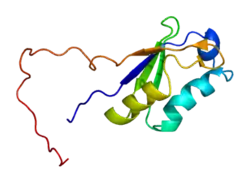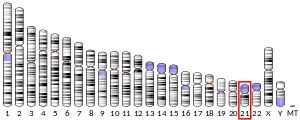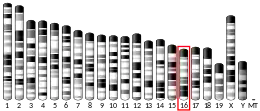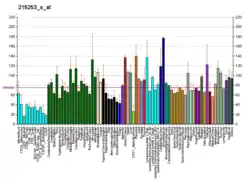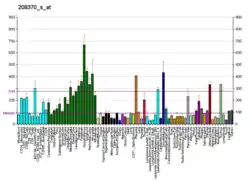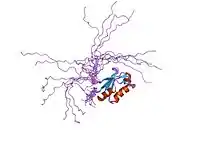RCAN1
Down syndrome critical region gene 1, also known as DSCR1, is a protein that in humans is encoded by the RCAN1 gene.[5]
Gene location and organization
DSCR1 in human is located at the centromeric border of the DSCR and encodes an inhibitor of calcineurin/ NFAT (nuclear factor activated T cells) signalling.[6]
DSCR1 genomic sequence of total 45 kb contain 7 exons and 6 introns , different cDNA analysis yield first four exons are alternative and code for two isoforms of 197 amino acids, and one isoform code for 171 amino acids which differ in their N terminal . While the rest of the 168 residues are common. There is also alternative promoter region with about 900 bp between exon 3 and 4 suggesting that the fourth isoform might be penetrated from another promoter.[7]
Function
The protein encoded by this gene interacts with calcineurin A and inhibits calcineurin-dependent signaling pathways of genetic transcription, possibly affecting central nervous system development. Three transcript variants encoding three different isoforms have been found for this gene.[5] In endothelial cells, VEGF stimulates RCAN1.4 expression which regulates gene expression, cell migration and tubular morphogenesis.[8]
Structure
DSCR1 Consist of putative functional motifs and calcineurin binding domain. DSCR1 contains two proline-rich SH3 binding domain, usually named proline-rich domain (PRD), which defines the protein family. SH3 domains or PRD are very important to allow the binding of the protein to endocytosis-related proteins such as ITSN1 and amphiphysin 1 and 2.[9]
Clinical significance
This gene is located in the minimal candidate region for the Down syndrome phenotype, and is overexpressed in the brain of Down syndrome fetuses. Chronic overexpression of this gene may lead to neurofibrillary tangles such as those associated with Alzheimer's disease.[5][10] RCAN1 helps coordinate whole-body metabolism and can be an important target in treatment of obesity.[11]
Associated diseases
Central nervous system
All Down syndrome (DS) patients develop neuropathological changes identical to the pathogenesis of Alzheimer's disease (AD) in middle age, such as neuritic plaques and neuronal loss. Therefore, DS patients are perfect models to study AD pathogenesis.[12] Chronic DSCR1 overexpression is related with DS and AD,[13] while its shortage is reported in Huntington’s disease.[14] DSCR1 expressed excessively in the Central Nervous System of embryos, and the protein is later overexpressed in brains of DS patients. However, neurotrophic peptide PACAP (or Pituitary adenylate cyclase-activating peptide) which is responsible for the development, differentiation, and survival, and various parts of memory and learning, targets RCAN1, a Down syndrome related gene, induces the expression of regulator of calcineurin 1, through activation of the PKA-CREB pathway, and this is important to understand the mechanisms of neural differentiation and aim for proper expression of RCAN1.[15]
Cancer
It is suggested that the reason patients with Down syndrome are less predisposed to certain cancers is due to the impact of this gene of reducing blood supply to tumour cells.[16] It is also proposed by epidemiological studies that DS patients are in greater risk of leukaemia, on the other hand they are at lower risk of cancer and other angiogenesis related diseases such as diabetic retinopathy and atherosclerosis, indicating that one or more trisomic genes on chromosome 21 is responsible for protecting DS patients against cancer, and this cancer defence could be a result of angiogenesis suppression.[16]
Interactions
DSCR1 has been shown to interact with Calcineurin.[17]
Hydrogen peroxide (H2O2) increases the overexpression of protein RCAN1. However, anti-oxidants and inhibitors of mitogen-activated protein kinases (MAPK) treatment block the increased expression of RCAN1 by H2O2. Demonstrating that the increased expression is a result of generating reactive oxygen species and activation of MAPK. Furthermore, phosphorylation is important to regulator RCAN1 protein expression. Because phosphorylation of RCAN1 expression by H2O2 increases of the half-life of the protein.[18]
References
- GRCh38: Ensembl release 89: ENSG00000159200 - Ensembl, May 2017
- GRCm38: Ensembl release 89: ENSMUSG00000022951 - Ensembl, May 2017
- "Human PubMed Reference:". National Center for Biotechnology Information, U.S. National Library of Medicine.
- "Mouse PubMed Reference:". National Center for Biotechnology Information, U.S. National Library of Medicine.
- "RCAN1 regulator of calcineurin 1 [ Homo sapiens (human) ]". Retrieved 2022-12-28.
- Arron JR, Winslow MM, Polleri A, Chang CP, Wu H, Gao X, et al. (June 2006). "NFAT dysregulation by increased dosage of DSCR1 and DYRK1A on chromosome 21". Nature. 441 (7093): 595–600. Bibcode:2006Natur.441..595A. doi:10.1038/nature04678. PMID 16554754. S2CID 4428187.
- Pfister SC, Machado-Santelli GM, Han SW, Henrique-Silva F (September 2002). "Mutational analyses of the signals involved in the subcellular location of DSCR1". BMC Cell Biology. 3: 24. doi:10.1186/1471-2121-3-24. PMC 128833. PMID 12225619.
- Holmes K, Chapman E, See V, Cross MJ (July 2010). "VEGF stimulates RCAN1.4 expression in endothelial cells via a pathway requiring Ca2+/calcineurin and protein kinase C-delta". PLOS ONE. 5 (7): e11435. Bibcode:2010PLoSO...511435H. doi:10.1371/journal.pone.0011435. PMC 2897886. PMID 20625401.
- Keating DJ, Chen C, Pritchard MA (November 2006). "Alzheimer's disease and endocytic dysfunction: clues from the Down syndrome-related proteins, DSCR1 and ITSN1". Ageing Research Reviews. 5 (4): 388–401. doi:10.1016/j.arr.2005.11.001. PMID 16442855. S2CID 12867672.
- Martin KR, Corlett A, Dubach D, Mustafa T, Coleman HA, Parkington HC, et al. (July 2012). "Over-expression of RCAN1 causes Down syndrome-like hippocampal deficits that alter learning and memory". Human Molecular Genetics. 21 (13): 3025–41. doi:10.1093/hmg/dds134. PMID 22511596.
- Rotter, David; Peiris, Heshan; Grinsfelder, D. Bennett; Martin, Alyce M.; Burchfield, Jana; Parra, Valentina; Hull, Christi; Morales, Cyndi R.; Jessup, Claire F.; Matusica, Dusan; Parks, Brian W. (December 2018). "Regulator of Calcineurin 1 helps coordinate whole-body metabolism and thermogenesis". EMBO Reports. 19 (12): e44706. doi:10.15252/embr.201744706. ISSN 1469-3178. PMC 6280800. PMID 30389725.
- Sun X, Wu Y, Herculano B, Song W (2014-04-21). "RCAN1 overexpression exacerbates calcium overloading-induced neuronal apoptosis". PLOS ONE. 9 (4): e95471. Bibcode:2014PLoSO...995471S. doi:10.1371/journal.pone.0095471. PMC 3994074. PMID 24751678.
- Ermak G, Morgan TE, Davies KJ (October 2001). "Chronic overexpression of the calcineurin inhibitory gene DSCR1 (Adapt78) is associated with Alzheimer's disease". The Journal of Biological Chemistry. 276 (42): 38787–94. doi:10.1074/jbc.M102829200. PMID 11483593. S2CID 38420676.
- Ermak G, Hench KJ, Chang KT, Sachdev S, Davies KJ (May 2009). "Regulator of calcineurin (RCAN1-1L) is deficient in Huntington disease and protective against mutant huntingtin toxicity in vitro". The Journal of Biological Chemistry. 284 (18): 11845–53. doi:10.1074/jbc.M900639200. PMC 2673253. PMID 19270310.
- Lee EH, Kim SS, Lee S, Baek KH, Seo SR (August 2015). "Pituitary Adenylate Cyclase-activating Polypeptide (PACAP) Targets Down Syndrome Candidate Region 1 (DSCR1/RCAN1) to control Neuronal Differentiation". The Journal of Biological Chemistry. 290 (34): 21019–31. doi:10.1074/jbc.M115.639476. PMC 4543660. PMID 26157140.
- Baek KH, Zaslavsky A, Lynch RC, Britt C, Okada Y, Siarey RJ, et al. (June 2009). "Down's syndrome suppression of tumour growth and the role of the calcineurin inhibitor DSCR1". Nature. 459 (7250): 1126–30. Bibcode:2009Natur.459.1126B. doi:10.1038/nature08062. PMC 2724004. PMID 19458618.
- Fuentes JJ, Genescà L, Kingsbury TJ, Cunningham KW, Pérez-Riba M, Estivill X, de la Luna S (July 2000). "DSCR1, overexpressed in Down syndrome, is an inhibitor of calcineurin-mediated signaling pathways". Human Molecular Genetics. 9 (11): 1681–90. doi:10.1093/hmg/9.11.1681. PMID 10861295.
- Kim SS, Seo SR (2013-01-29). "Hydrogen peroxide-induced MAPK activation causes the increase of RCAN1 (DSCR1) protein expression". Genes & Genomics. 35 (1): 111–116. doi:10.1007/s13258-013-0080-x. ISSN 1976-9571. S2CID 15858776.
Further reading
- Harris CD, Ermak G, Davies KJ (November 2005). "Multiple roles of the DSCR1 (Adapt78 or RCAN1) gene and its protein product calcipressin 1 (or RCAN1) in disease". Cellular and Molecular Life Sciences. 62 (21): 2477–86. doi:10.1007/s00018-005-5085-4. PMID 16231093. S2CID 7184948.
- Keating DJ, Chen C, Pritchard MA (November 2006). "Alzheimer's disease and endocytic dysfunction: clues from the Down syndrome-related proteins, DSCR1 and ITSN1". Ageing Research Reviews. 5 (4): 388–401. doi:10.1016/j.arr.2005.11.001. PMID 16442855. S2CID 12867672.
- Fuentes JJ, Pritchard MA, Planas AM, Bosch A, Ferrer I, Estivill X (October 1995). "A new human gene from the Down syndrome critical region encodes a proline-rich protein highly expressed in fetal brain and heart". Human Molecular Genetics. 4 (10): 1935–44. doi:10.1093/hmg/4.10.1935. PMID 8595418.
- Andersson B, Wentland MA, Ricafrente JY, Liu W, Gibbs RA (April 1996). "A "double adaptor" method for improved shotgun library construction". Analytical Biochemistry. 236 (1): 107–13. doi:10.1006/abio.1996.0138. PMID 8619474.
- Yu W, Andersson B, Worley KC, Muzny DM, Ding Y, Liu W, et al. (April 1997). "Large-scale concatenation cDNA sequencing". Genome Research. 7 (4): 353–8. doi:10.1101/gr.7.4.353. PMC 139146. PMID 9110174.
- Fuentes JJ, Pritchard MA, Estivill X (September 1997). "Genomic organization, alternative splicing, and expression patterns of the DSCR1 (Down syndrome candidate region 1) gene". Genomics. 44 (3): 358–61. doi:10.1006/geno.1997.4866. PMID 9325060.
- Rothermel B, Vega RB, Yang J, Wu H, Bassel-Duby R, Williams RS (March 2000). "A protein encoded within the Down syndrome critical region is enriched in striated muscles and inhibits calcineurin signaling". The Journal of Biological Chemistry. 275 (12): 8719–25. doi:10.1074/jbc.275.12.8719. PMID 10722714.
- Fuentes JJ, Genescà L, Kingsbury TJ, Cunningham KW, Pérez-Riba M, Estivill X, de la Luna S (July 2000). "DSCR1, overexpressed in Down syndrome, is an inhibitor of calcineurin-mediated signaling pathways". Human Molecular Genetics. 9 (11): 1681–90. doi:10.1093/hmg/9.11.1681. PMID 10861295.
- Ermak G, Morgan TE, Davies KJ (October 2001). "Chronic overexpression of the calcineurin inhibitory gene DSCR1 (Adapt78) is associated with Alzheimer's disease". The Journal of Biological Chemistry. 276 (42): 38787–94. doi:10.1074/jbc.M102829200. PMID 11483593.
- Vega RB, Yang J, Rothermel BA, Bassel-Duby R, Williams RS (August 2002). "Multiple domains of MCIP1 contribute to inhibition of calcineurin activity". The Journal of Biological Chemistry. 277 (33): 30401–7. doi:10.1074/jbc.M200123200. PMID 12063245.
- Genescà L, Aubareda A, Fuentes JJ, Estivill X, De La Luna S, Pérez-Riba M (September 2003). "Phosphorylation of calcipressin 1 increases its ability to inhibit calcineurin and decreases calcipressin half-life". The Biochemical Journal. 374 (Pt 2): 567–75. doi:10.1042/BJ20030267. PMC 1223619. PMID 12809556.
- Hesser BA, Liang XH, Camenisch G, Yang S, Lewin DA, Scheller R, et al. (July 2004). "Down syndrome critical region protein 1 (DSCR1), a novel VEGF target gene that regulates expression of inflammatory markers on activated endothelial cells". Blood. 104 (1): 149–58. doi:10.1182/blood-2004-01-0273. PMID 15016650.
- Michtalik HJ, Narayan AV, Bhatt N, Lin HY, Mulligan MT, Zhang SL, Crawford DR (August 2004). "Multiple oxidative stress-response members of the Adapt78 family". Free Radical Biology & Medicine. 37 (4): 454–62. doi:10.1016/j.freeradbiomed.2004.05.014. PMID 15256217.
- Iizuka M, Abe M, Shiiba K, Sasaki I, Sato Y (2004). "Down syndrome candidate region 1,a downstream target of VEGF, participates in endothelial cell migration and angiogenesis". Journal of Vascular Research. 41 (4): 334–44. doi:10.1159/000079832. PMID 15263820. S2CID 36918295.
- Yao YG, Duh EJ (August 2004). "VEGF selectively induces Down syndrome critical region 1 gene expression in endothelial cells: a mechanism for feedback regulation of angiogenesis?". Biochemical and Biophysical Research Communications. 321 (3): 648–56. doi:10.1016/j.bbrc.2004.06.176. PMID 15358155.
- Minami T, Horiuchi K, Miura M, Abid MR, Takabe W, Noguchi N, et al. (November 2004). "Vascular endothelial growth factor- and thrombin-induced termination factor, Down syndrome critical region-1, attenuates endothelial cell proliferation and angiogenesis". The Journal of Biological Chemistry. 279 (48): 50537–54. doi:10.1074/jbc.M406454200. PMID 15448146.
- Baek KH, Zaslavsky A, Lynch RC, Britt C, Okada Y, Siarey RJ, et al. (June 2009). "Down's syndrome suppression of tumour growth and the role of the calcineurin inhibitor DSCR1". Nature. 459 (7250): 1126–30. Bibcode:2009Natur.459.1126B. doi:10.1038/nature08062. PMC 2724004. PMID 19458618.
